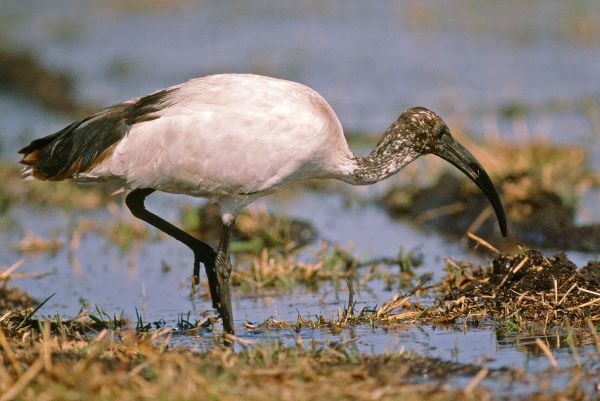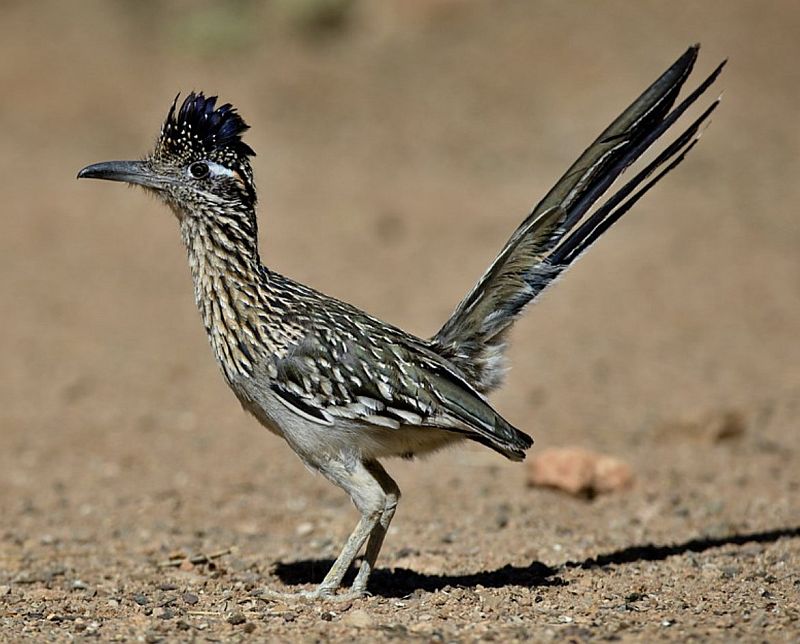Family: The sacred ibis (Threskiornis aethiopicus) is a member of the family Threskiornithidae in the order Pelecaniformes.
Identification: Both adult sexes are similar; however, males have longer bills. Both are white, except for the black tips of the primary and plumed outer secondary feathers and the spiny white plumes on the breast. The head and neck are naked and black, with pink bands on the nape. The naked scarlet stripe on the underwing and each side of the breast. The eyes are dark brown. The bill is black and carncled. The legs are pink, and the feet are purple-brown. The immature bird is similar to adults but with a feathered head and neck, spotty black and white, and no breast plumes. The downy young is white, with a black crown and neck; his bill and feet are pink-flesh.
Distribution: Sacred Ibis have been found in swamps, irrigated pastures, and shallow lake margins in the north and east; small but increasing colonies have been found in the southwest since the 1950s. Nomadic. Also in Africa, southern Asia, New Guinea, and the Solomon Islands; vagrants in Tasmania, New Zealand.
Habitat: In the air, Sacred Ibis often fly in groups strung out in a stepped or V-formation, like the Straw-necked Ibises with which they often associate. All birds in the formation flap their wings at the same time, then glide together. Occasionally, they soar, spiraling upward on thermal air currents to a height of around 2800–3000 meters, closely followed by spoonbills and pelicans.
Diet: On the ground, the Sacred Ibis forages only in swampy or water-covered ground. In the water, it moves its head from side to side, continuously probing with its sensitive bill for food—crustaceans, especially freshwater crayfish, water insects, fish, snails, and frogs. It also eats crickets, earthworms, and, occasionally, small snakes. When feeding, it occasionally holds its head and the upper portion of its neck underwater. When an ibis feeds on mussels, it holds the mussel by one foot on a hard surface and breaks the shell open with hard blows of its bill.

Breeding: Sacred Ibises do not begin breeding until their nesting grounds are flooded to a particular depth, usually at least a meter. It acts as a safety net against disaster since inland marshes have extreme water changes and the birds essentially abandon their nesting habitats when they begin to dry out quickly. At the start of breeding, flocks of males select a breeding site—generally the site used in previous years.
Each bird establishes a display territory on a nearby tree branch and becomes very noisy and aggressive towards other males, raising his feathers, snapping his bill, and displaying the scarlet bare patches under his wings. Once a male has secured display territory, he flies down to the bushes below and tramples a small area for a future nest site. The males tie deep bows from their branches to entice the females when they arrive. A female lands as close to a male as possible.
Then the male flies down to the nest territory, where he grasps a twig in his bill and performs several bows until the female flies down. Pairing is forged when both grasp the twig and preen one another. After copulation, the male collects nest material by removing branches from bushes and bringing them to the female, who constructs a platform nest.
Both birds incubate the eggs in shifts and greet each other with deep bows when changing over. Both also care for the young; one stands guard while the other gathers food. Young ibises solicit food by calling insistently and flapping whichever wing is closest to the adult. Wrapping this wing around the parent’s head, it pulls it down to reach in for food regurgitated from the capacious crop in the adult’s throat.
Parents do not feed young indiscriminately, not commencing until they have established vocal contact. The young stay together after leaving the nest. They settle on bushes for a further two weeks before they begin to fly. Then, they congregate in the nearby trees, where they are still fed by their parents. Once independent, young ibises may disperse over distances as far as 1200 kilometers.
Alternative Names: This bird is also known as White Ibis and Black-necked Ibis.
Movements: The longest journey recorded is from southern Victoria to New Guinea, more than 3000 kilometers. Movements appear to be north-south rather than east-west.
Size: Sacred Ibis measures 670–750 mm in length.
Vocalizations: Sacred Ibis flight call is a grunting urk; koaha, taw-taw, and taw-aw when breeding.
Nesting: Sacred Ibis nesting and breeding occur in colonies from September to April. Nest on a platform of sticks, built on low plants, generally in secluded places.
Eggs and Incubation: The bird lays 2–5 eggs, which are dull white, oval, tapered, and about 66 x 45 mm. The incubation period is about 20–25 days for both sexes. Young fledge in about four weeks.
Races: There are about six races, one of which is in Australia.
Read More: Glossy Ibis (Plegadis falcinellus)







